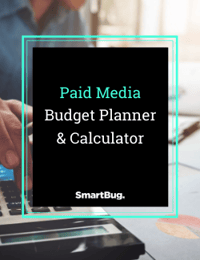
Creating and perfecting ad copy is an art, a science, and a strategic game. When winning that game comes down to single words or mere minutes, ad copy optimization with AI can give you a valuable assist.
Our ad copy experts recently jumped into the world of ad copy optimization with AI. The takeaway? We’ve found AI can save 30-50 percent of the time it takes to write decent ads—but human strategy and creativity are what will take your ads across the finish line, every time.
What Is Ad Copy Optimization? (And How Can AI Help?)
Ad copy optimization is the process of refining and enhancing the text of your advertisements—headlines, descriptions, and calls to action—to maximize their impact.
The goal is simple: You want every word to resonate with your target audience. You want every character to compel potential customers into taking action.
As it turns out, AI's capabilities can fit nicely into the entire advertising process.
The Benefits of Managing Ad Copy Optimization with AI
Here’s what our team has seen work well after experimenting with AI ad copy tools:
- AI can help you save time. Using generative AI to produce headlines and descriptions can cut hours out of the brainstorming and drafting process.
- AI can help you boost accuracy. Digital advertising allows little leeway for typos and target mismatches. AI can help you reduce these types of oversights.
- AI can help you achieve consistency. With copy tools that allow you to define brand voice and style parameters, you can produce endless content that feels seamless.
- AI can give your team room for creativity, research, and strategy. By saving time and applying technical tweaks through ad copy optimization with AI, your creative team can have more bandwidth for what they do best.
AI can also support broader paid media initiatives, such as itemizing ad budgets, optimizing the bidding process, tracking ROI, and even managing entire ad campaigns to support peak performance. We’re particularly excited about software such as Albert.ai, an autonomous tool supporting digital marketing campaigns from start to finish, which can save teams a lot of time and headaches during campaign rollout!
But let’s get back to ad copy. If you’re looking to boost ad copy optimization with AI, what (specifically) do you need to do?
Your Ad Copy Playbook: Optimizing Your Ads with AI
Say you’ve got a long list of headlines to write, and you suspect AI can help you get the job done. It can. Here’s your ad copy optimization to-to list, aided and abetted by your AI toolkit:
- Use AI to produce draft versions of needed headlines, descriptions, and CTAs. Edit them, try them out, and keep alternatives for A/B testing.
- Use AI to personalize your draft ad copy by including information about your audience segments in your prompt.
- Use AI to analyze your customer and company data to predict which ad copy variations will perform well.
- Use AI to analyze the sentiment of your audience and the emotional impact of your ad copy to further your connection with your target demo.
- Use AI to adapt your ad copy into regional vernacular or entirely different languages, if needed. (And then have your team check the output—twice.)
- Use AI to integrate your target keywords into your drafted ad copy.
- Use AI to analyze your competitors’ campaigns, and use that info to inform your own ad strategy.
- Use AI to refine your ad copy based on feedback you receive from clients and your team.
- Use AI to identify trending topics and new best practices, then incorporate them into your content.
As impressive as this AI-enhanced ad copy optimization list is, you can’t stop there.
First of all, it bears repeating: Any output you receive needs to be checked and edited thoroughly.
Secondly: Simply using AI to optimize your ad copy won’t help you outperform your competitors. (Think about it: Your competitors have access to the same tech.) What sets you apart from your competitors is the strength of your human team.
Truly outshining your competition will require striking the right balance between the precision of AI and the creativity of your ad copy experts.
With the time saved using the above strategies, consider performing these human-only optimizations to stay ahead of the curve:
- Add emotional resonance to your ad copy.
- Weave a compelling narrative around your product or service.
- Incorporate timely, culturally relevant references in your ads.
- Engage with your audience through surveys, feedback requests, or even casual conversations—then use the insights you’ve gleaned to refine your copy.
- Experiment with humor to pepper your ads with well-placed puns and witty remarks.
- Ensure your ad copy is socially responsible and relevant and that it doesn’t inadvertently perpetuate any biases or stereotypes—so your brand is always positive and inclusive.
Challenges of Using AI for Ad Copy Optimization: Avoid These Curveballs!
Ad copy optimization with AI comes with many benefits, but there are certainly obstacles to avoid.
For example:
- Don’t over-rely on AI. Using it (and it alone) to generate ad copy will lead to generic, misaligned content.
- Don’t ignore customer feedback. Your AI tool may not have access to critical information, such as what your customers are saying in real time. Remember to use all the information at your disposal!
- Be aware of AI’s limitations. In our tests, we found that AI falters with using specific brand names and branded information in its output, sometimes returning inaccurate information or clunky wording. Be prepared to spend time editing AI copy to make it work for you and your clients!
- Watch out for repetitive AI output. We’ve also noticed that AI tends to rehash the same headlines over and over, or overuse syntax even when prompted not to. (Anyone who’s tried to generate headlines without ChatGPT’s preference for colons knows exactly what we’re talking about!)
To navigate these challenges, make sure ...
... that you’re using the right tools. From your ad platforms (such as Google Ads and Facebook Ads) to AI content tools (such as Jasper and Copy.ai) and SEO tools (such as Semrush), don’t forget to use all the features of all the tools in your tech stack.
(And if you have a keyword research tool, use it, not ChatGPT, for research.)
... that you’re preparing well for AI use. Before you write any prompts, remember that you need well-defined goals and specific strategies for your campaign. You need to know your campaign’s objective, which platform you’re using, the audience you’re targeting, and more before getting started.
Remember: AI tools can significantly enhance your campaigns, but it’s on you to provide them with the right direction.
... that you’re staying up to date on the latest AI innovations. Every week brings with it a new AI tool or trick of the trade. Keep your finger on the pulse to ensure you’re not missing out on the latest trends and developments in AI and online advertising.
... that you can track how effective your AI-supported workflow is—and, of course, how the resulting ads perform.
Track the hours you save generating copy, monitor click-through rates and engagement metrics, and collect user feedback on AI-generated content to ensure that, as you save time, your KPIs are trending in the right direction.
What’s Next for Ad Copy Optimization with AI?
The next few years may see significant change within the marketing industry, but that doesn’t have to be stressful. Ad copy and content marketing teams need to adopt a flexible mindset and seek out continuous learning opportunities to make sure they stay on the cutting edge. This opportunity to upskill and invest in more creative content can be exciting, but it will require a thoughtful approach and effort up front.
For now? The next time you’re writing a batch of headlines, open up your generative AI platform of choice and see if any of the tips we’ve mentioned save you time or help you find a new creative angle to explore. We bet you’ll find something intriguing to include—which means there’s a good chance your dream customers will find the copy intriguing as well.
As you uncover more ways to level up your ad copy optimization with AI, we’ve got a handy tool to help you ensure your campaigns stay on track. Check it out: Paid Media Budget Planner & Calculator.

About the author
Michael Birky was formerly the Director of Paid Media based out of Westfield, Indiana. He has a demonstrated history in designing and executing multi-channel paid digital marketing campaigns. He also currently manages the Paid Media team here at Smartbug Media. Michael tries to spend as much time outdoors as he can as he is an avid outdoorsman. Read more articles by Michael Birky.








